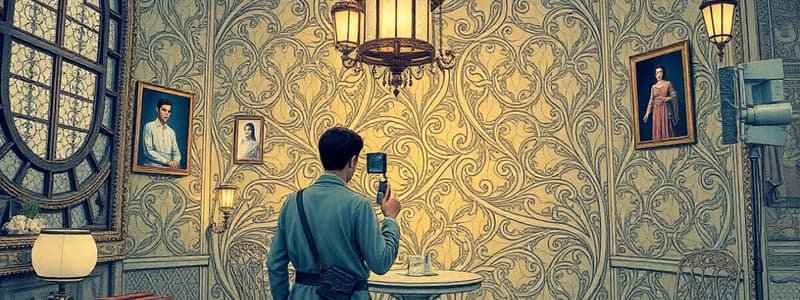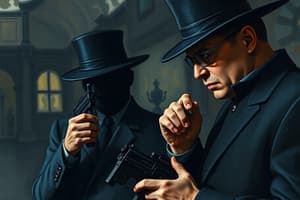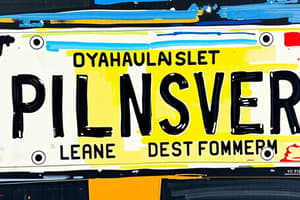Podcast
Questions and Answers
What advantage do women have in roles involving undercover work?
What advantage do women have in roles involving undercover work?
- They can easily dominate criminal organizations.
- Their beauty and intelligence can help them extract secrets from men. (correct)
- They can build trust more quickly with male criminals.
- They are less likely to be suspected of espionage.
What could excessive boasting by an agent lead to?
What could excessive boasting by an agent lead to?
- Being discovered as an impostor. (correct)
- Enhanced credibility in the field.
- Improved rapport with informants.
- Greater success in missions.
Which technique is NOT mentioned as a method for tracing a criminal?
Which technique is NOT mentioned as a method for tracing a criminal?
- Tailing family members of the criminal.
- Employing children to unknowingly disclose locations.
- Following the criminal to their hideouts. (correct)
- Using informants to gather information.
What consequence may arise from moderate expenditures for an agent?
What consequence may arise from moderate expenditures for an agent?
How can interrogating arrested criminals benefit an investigation?
How can interrogating arrested criminals benefit an investigation?
What is the primary goal of adapting inconspicuous clothing and accessories?
What is the primary goal of adapting inconspicuous clothing and accessories?
In the one-man shadowing technique, what should the surveillant do if the subject uses a telephone booth?
In the one-man shadowing technique, what should the surveillant do if the subject uses a telephone booth?
What is an advantage of the two-man shadowing technique?
What is an advantage of the two-man shadowing technique?
Which characteristic is NOT essential for a person conducting surveillance according to the description provided?
Which characteristic is NOT essential for a person conducting surveillance according to the description provided?
What should a surveillant do when the subject turns a corner?
What should a surveillant do when the subject turns a corner?
When is it necessary for the surveillant to follow the subject inside a building?
When is it necessary for the surveillant to follow the subject inside a building?
In the ABC technique of shadowing, what is the role of the shadower 'C'?
In the ABC technique of shadowing, what is the role of the shadower 'C'?
What is an essential element of the cover story according to the text?
What is an essential element of the cover story according to the text?
What should the surveillant do if there are multiple shadowers?
What should the surveillant do if there are multiple shadowers?
In which scenario should the shadower take note of the taxi's plate number?
In which scenario should the shadower take note of the taxi's plate number?
What is crucial for the shadower to do inside a restaurant?
What is crucial for the shadower to do inside a restaurant?
How should the shadower behave in a private house?
How should the shadower behave in a private house?
What strategy does a subject use to determine if they are being tailed?
What strategy does a subject use to determine if they are being tailed?
What quality is essential for a good undercover agent?
What quality is essential for a good undercover agent?
What should a shadower do when riding a bus with the subject?
What should a shadower do when riding a bus with the subject?
What should the shadower do before entering a restaurant?
What should the shadower do before entering a restaurant?
Which quality is essential for an undercover agent in maintaining their cover?
Which quality is essential for an undercover agent in maintaining their cover?
What does the 'residential assignment' involve?
What does the 'residential assignment' involve?
What is a critical guideline for undercover agents in social assignments?
What is a critical guideline for undercover agents in social assignments?
Why is having a photographic memory important for an undercover agent?
Why is having a photographic memory important for an undercover agent?
What should undercover agents avoid to prevent generating suspicion?
What should undercover agents avoid to prevent generating suspicion?
Which type of assignment involves understanding criminal ideologies?
Which type of assignment involves understanding criminal ideologies?
What is a known risk for agents regarding interpersonal relationships?
What is a known risk for agents regarding interpersonal relationships?
What is essential for agents when creating a fictitious personality?
What is essential for agents when creating a fictitious personality?
What is the role of a surveillant?
What is the role of a surveillant?
Which of the following best describes fixed surveillance?
Which of the following best describes fixed surveillance?
What is shadowing or tailing in surveillance?
What is shadowing or tailing in surveillance?
Which surveillance tool is specifically designed for capturing distant images?
Which surveillance tool is specifically designed for capturing distant images?
Which intelligence organization is associated with the United Kingdom?
Which intelligence organization is associated with the United Kingdom?
What does 'roping' refer to in the context of surveillance?
What does 'roping' refer to in the context of surveillance?
Which of the following is NOT a tool used in fixed surveillance?
Which of the following is NOT a tool used in fixed surveillance?
What characteristic is essential for a surveillant's personal appearance?
What characteristic is essential for a surveillant's personal appearance?
Flashcards
Surveillance
Surveillance
The discreet observation of people, places, or vehicles to gather information about criminal activity.
Surveillant
Surveillant
The person who conducts surveillance or observes the subject.
Subject
Subject
The person, group, or place being observed during surveillance.
Fixed Surveillance
Fixed Surveillance
Signup and view all the flashcards
Moving Surveillance
Moving Surveillance
Signup and view all the flashcards
Shadowing/Tailing
Shadowing/Tailing
Signup and view all the flashcards
Roping
Roping
Signup and view all the flashcards
Intelligence Agencies
Intelligence Agencies
Signup and view all the flashcards
Inconspicuous Appearance
Inconspicuous Appearance
Signup and view all the flashcards
Avoid Noticeable Peculiarities
Avoid Noticeable Peculiarities
Signup and view all the flashcards
Cover Story
Cover Story
Signup and view all the flashcards
One-Man Shadow
One-Man Shadow
Signup and view all the flashcards
Two-Man Shadow
Two-Man Shadow
Signup and view all the flashcards
Three-Man Shadow (ABC Technique)
Three-Man Shadow (ABC Technique)
Signup and view all the flashcards
Turning Corners
Turning Corners
Signup and view all the flashcards
Entering a Building
Entering a Building
Signup and view all the flashcards
Elevator Surveillance
Elevator Surveillance
Signup and view all the flashcards
Bus Surveillance
Bus Surveillance
Signup and view all the flashcards
Taxi Surveillance
Taxi Surveillance
Signup and view all the flashcards
Train Surveillance
Train Surveillance
Signup and view all the flashcards
Restaurant Surveillance
Restaurant Surveillance
Signup and view all the flashcards
Hotel Surveillance
Hotel Surveillance
Signup and view all the flashcards
Theater Surveillance
Theater Surveillance
Signup and view all the flashcards
Private House Surveillance
Private House Surveillance
Signup and view all the flashcards
Women Agents
Women Agents
Signup and view all the flashcards
Bragging
Bragging
Signup and view all the flashcards
Moderate Expenditures
Moderate Expenditures
Signup and view all the flashcards
Using Children
Using Children
Signup and view all the flashcards
Harassing Associates
Harassing Associates
Signup and view all the flashcards
Photographic Memory
Photographic Memory
Signup and view all the flashcards
Keen Power of Observation
Keen Power of Observation
Signup and view all the flashcards
Sound Judgement
Sound Judgement
Signup and view all the flashcards
Work Assignment
Work Assignment
Signup and view all the flashcards
Social Assignment
Social Assignment
Signup and view all the flashcards
Subversive Organizations
Subversive Organizations
Signup and view all the flashcards
Residential Assignment
Residential Assignment
Signup and view all the flashcards
Fictitious Personality
Fictitious Personality
Signup and view all the flashcards
Study Notes
Surveillance Definition
- Surveillance is defined as the discreet observation of people, places, and vehicles.
- The goal is to gather information about criminals' identities or activities.
- The person conducting surveillance is called a surveillant.
- The person or group being observed is the subject.
Types of Surveillance
Fixed Surveillance
- Usually performed in a specific location (building or premise.)
- The surveillant remains stationary while observing.
- Methods include using cameras with telephoto lenses, binoculars, and recording devices.
- Other surveillants might pose as workers (e.g., carpenters, plumbers), communicating with those in a central observation room.
Moving Surveillance
- The surveillant moves (on foot or in vehicles) to observe the subject.
Tools Used in Fixed Surveillance
- Binoculars or telescopes
- Movie cameras with telephoto lenses
- Wiretapping devices with recording equipment
- Other listening devices
- Lip-reading experts (used if wiretapping is difficult).
Shadowing and Tailing
- Shadowing (or tailing) is following a subject to detect criminal activity.
- It can also be used to establish associations or find wanted people.
- Roping is a type of undercover work where the surveillant has a different role and identity to gather information.
Intelligence Organizations
- United States: Central Intelligence Agency (CIA)
- Soviet Union: Komitet Gosudarstvennoy Bezopasnosti (KGB)
- United Kingdom: Security Service (MI5), Wartime Designation (MI6)
- France: Service de Documentation Extérieure et de Contre-Espionnage (SDECE)
- China: Central Committee of the Communist Party (CCP)
- Israel: Mossad
- Philippines: Intelligence agencies vary by law enforcement agency (e.g., PNP, NBI, AFP).
Personal Appearance of the Surveillant
- The surveillant should have an average height and build that blends in with the crowd.
- Clothes, jewelry, and grooming should be inconspicuous.
- The appearance should not draw attention.
- The surveillant should be able to react to unexpected situations.
- Cover stories must be believable if acting in a specific role (e.g., vendor).
Methods of Foot Surveillance
- One-Man Shadow: One surveillant follows the subject. Information is gathered on the subject's contacts, places visited, and associates.
- Two-Man Shadow: Two surveillants follow the subject, exchanging positions to avoid detection.
- Three-Man Shadow (ABC Technique): Three surveillants are positioned at varied distances around the subject to provide a wider field of observation/
Tactics in Shadowing
- Turning Corners: The surveillant should be cautious and not rush when the subject turns a corner.
- Entering a Building and Avoiding Detection: Tactics in entering and exiting buildings to surveil should be used.
- Riding a Bus or Taxi: The surveillant should board the same bus or taxi used by the subject.
- Inside a Restaurant: The surveillant should wait before entering the restaurant, choose a less obvious table, and try to finish eating at the same time as the subject.
- Inside a Theater or Private House: The surveillant should sit or wait discreetly according to the situation.
- Inside a Small Private/Public Office: Wait outside, pretending to be a customer.
Tricks of the Subject
- Jumping off Public Transport: To avoid detection.
- Use of Convoy: Using accomplices to detect if being followed.
Qualities of a Good Undercover Agent
- Temperament (calm, enduring, affable)
- Photographic Memory
- Adaptability
- Observational Skills
- Knowledge of varied lives, professions, and occupations
Specific Types of Undercover Assignments
- Work Assignment (e.g., janitor)
- Social Assignment (e.g., bars, nightclubs)
- Subversive Organizations
- Residential Assignment (finding housing near the suspect)
- Fictitious Background (creating a false persona)
Don'ts in Assignments
- Don't drink too much
- Don't court women (complex situations)
Tracing and Arresting the Criminal
- Using Informants: Gaining information from associates, family, and friends.
- Using children to trace the criminal
- Harassing associates for information
- Interrogation with false details
- Undermining power struggles
Studying That Suits You
Use AI to generate personalized quizzes and flashcards to suit your learning preferences.





